
Ever wonder how those guys on CSI can identify a murderer by their fingerprints? Is it really as easy as they make it seem? Fingerprints are the little ridges on the end of your fingers and thumb. They are arranged in a pattern of spirals and loops. Nature evolved these to help us grip and hold on to things. The texture prevents things from slipping and sliding as would naturally happen if our skin were smooth, and especially if our hands are wet or sweaty. In the early 1900s, people began to realize that fingerprints were unique -- no two people have exactly the same pattern. Fingerprint patterns are inherited but are never exactly identical. Even in cases of identical twins, the patterns will vary slightly. Sir Francis Galton was the first to use this knowledge in solving criminal cases at Scotland Yard in England. In 1900 he introduced the technique of comparing prints at found at a crime scene with those of a suspect. He based much of his work on the observations of Sir Edmund Henry and, together, their approach was called the Galton-Henry System. In 1904, Juan Vucetich, working for a police department in Argentina, published a paper titled, Comparative Fingerprints. His techique is still widely used in Spanish speaking countries. All of these systems are basically similar. Edmund Henry recognized that fingerprints could be described as having patterns of loops, arches or whirls. These shapes and contours were later developed to eight basic patterns, which are still used by the FBI today.  Radial loop - this is a concentric pattern. The pattern is slanted towards the radial bone, the thick bone on the thumb side of the hand. Ulnar loop - this the most common pattern and is made up of ridges that resemble hairpins or staples. It sometimes resembles the radial loop but slants towards the small bone of the arm, the ulna, on the same side as the little finger. Plain arch - this is a mound like pattern. Tented arch - this patter resembles a church steeple. Plain whorl - this is a circular spiral pattern. Accidental - this is another, irregular circular pattern. Double loop - this is, as the name describes, two looped patterns. Central pocket- this is characterized by a tight circular pattern in the center of the print. The distribution of these pattern in the population are as follows: 65% have loops, 30% have whirls, 5% have arches. The most common feature is the Ulnar Loop
Fingerprints are taken when an individual is arrested, whether or not they are eventually convicted or are innocent. In some cases, the record of an innocent party can be purged, but usually these remain in the system and make their way from the local police department to the national FBI system. Immigrants are fingerprinted when they apply for their visa and every person entering the military is likewise fingerprinted. Federal employees, especially those requiring a security clearnance, are also fingerprinted to determine if they have ever been arrested or convicted of a crime.
Fingerprints result when the ridges on the finger tips press a surface and change it. This change can be either depositing oils or by leaving traces of other substances, such as food, cosmetics or even dirt. It's a common misconception that fingerprints are mainly left by skin oil. Usually, the liquid on the surface of our skin is 98% water, combined with other substances like salt or urea, from sweat. It's important to know this because the techniques used to reveal prints must be carefully applied or they will destroy the prints. On the television shows, we commonly see CSI agents dusting a surface with powder. This is good for porous surfaces like paper, cardboard and wood but is not appropriate for smooth surfaces like glass or metal. Dusting these smooth surfaces will actually destroy the prints and wipe them clean. If a glass or other non-porous surface is collected for analysis, care must be taken not to allow the surface to come in contact with anything. Therefore, putting the items in a plastic or paper bag or box will run the risk of destroying the print. These items need to be carefully packaged at the crime scene so that the suspected prints do not touch anything.
These items can later be inspected with special lights, lasers or subjected to superglue vapors, which will reveal the ridge patterns left by trace amounts of debris. Prints left on non-porous surfaces can last for many years. For porous surfaces, dusting is fine. The material transferred by the fingerprint is usually absorbed into the surface and resists scuffing or earasing by contact with other material. By applying a special dust with a very fine brush the ridge impressions allow the dust particles to adhere and then can be either photographed or transferred to something like clear tape for subsequent analysis. You may have seen CSI agents on the television entering a crime scene with no lights, carrying small flashlights. This is because things like fingerprints and footprints left in household dust can often be seen better when they are illuminated from an angle with a single light source, instead of by an ambient bright light. Things like cigarettes, aluminum cans, plastic, gabage bags, bed sheets and even human bodies can all be fingerprinted with today's modern techniques. 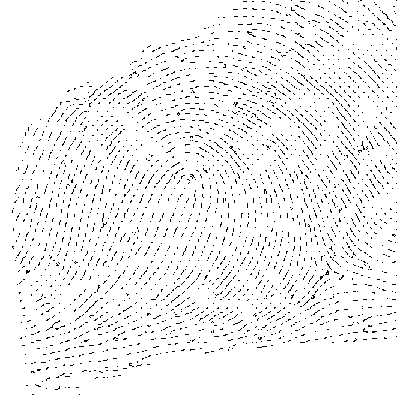 Not all fingerprints are of good quality and some may be deemed inadmisable in court because of their lack of definition. The print above is an example of a poor quality print. Such a print may be helpful to law enforement in either eliminating or including a suspect but it lacks the certainty to provide for a match. 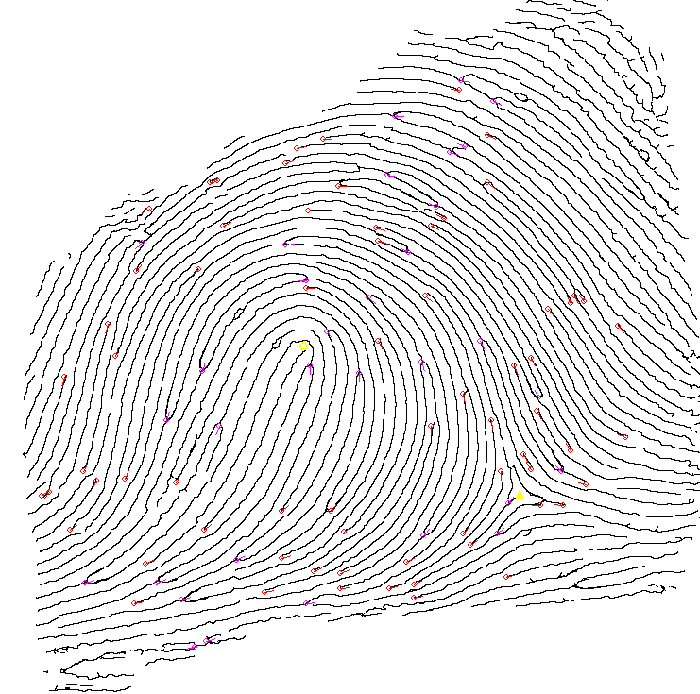 For many years, the FBI and many police department employed individuals who would meticulously examine and compare fingerprints manually. This was a lengthy procedure and very inefficient. Later, computerized systems have been introduced which narrow the search and refine the matches, ranking them on the number of similar features. These computer programs rely on the identification of the varios types of patterns, their size and relative positions to eachother. The print above is a good quality print and various patterns and points of interest have been marked in magenta and red.
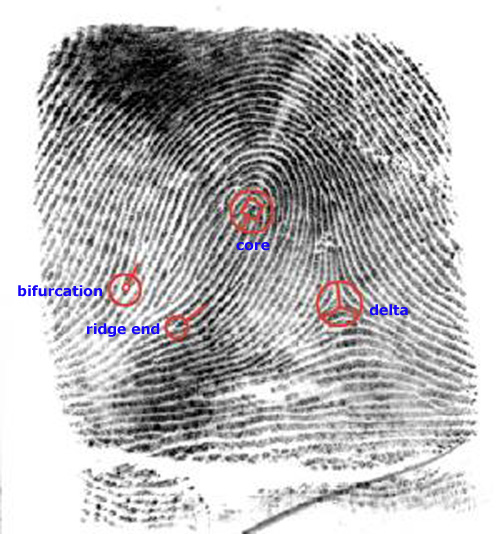
Computer software scans the prints, assigns x-y coordinates for the minutia, then converts the map into a data file. Once the prints have been converted into numbers a search can begin to sort out similar files for further comparison. Eventually, if enough coordinates overlap, a possible match is flagged for a more detailed analysis. Are you ready? Look at your own fingerprints. What style do you have?
|

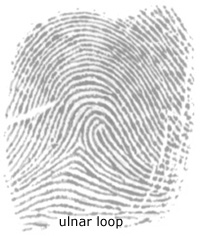 As early as 1903, fingerprints were in use at Leavenworth Prison in New York State and also the prison at St. Louis, Missouri, to identify and document prisoners after their arrest and incarceration. The New York State Civil Service Commission first used fingerprints of civilians to identify applicants, eliminating the practice of having a more qualified "friend" take the test for the lucrative jobs. By 1921 fingerprints were being collected on a large scale by the FBI's newly founded Identification Division. This department has grown over the years and now contains prints for more than 400-million criminals and ivilians. Today, an average of 8000 records are added every day!
As early as 1903, fingerprints were in use at Leavenworth Prison in New York State and also the prison at St. Louis, Missouri, to identify and document prisoners after their arrest and incarceration. The New York State Civil Service Commission first used fingerprints of civilians to identify applicants, eliminating the practice of having a more qualified "friend" take the test for the lucrative jobs. By 1921 fingerprints were being collected on a large scale by the FBI's newly founded Identification Division. This department has grown over the years and now contains prints for more than 400-million criminals and ivilians. Today, an average of 8000 records are added every day!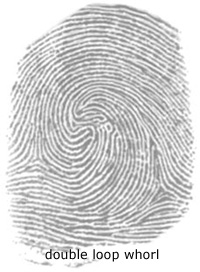 In some instances, innocent people may be asked to give their fingerprints to eliminate them from suspicion at a crime scene.
In some instances, innocent people may be asked to give their fingerprints to eliminate them from suspicion at a crime scene.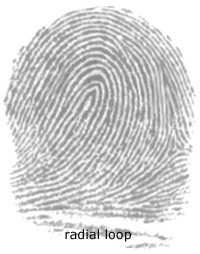 Even picking up a non-porous item with a handkerchief or glove can damage the prints.
Even picking up a non-porous item with a handkerchief or glove can damage the prints.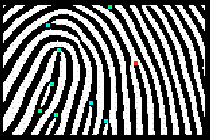 The specific patterns and their positions would then be coded and entered into a computer program which would systematically look for other prints with similar codes. The codes, called a "minutia map," mark the location of such things as a bifurcation where a line breaks into two separate lines, a delta where three lines join together, a core defines the center of a whirl or the peak of an arch, and a ridge ending where a line ends. The maps are compared and considered a "match" when at least 12 points of a suspected print coincide with 12 points of a print on file. A good set of prints will usually have as many as 50 coinciding minutia points.
The specific patterns and their positions would then be coded and entered into a computer program which would systematically look for other prints with similar codes. The codes, called a "minutia map," mark the location of such things as a bifurcation where a line breaks into two separate lines, a delta where three lines join together, a core defines the center of a whirl or the peak of an arch, and a ridge ending where a line ends. The maps are compared and considered a "match" when at least 12 points of a suspected print coincide with 12 points of a print on file. A good set of prints will usually have as many as 50 coinciding minutia points.